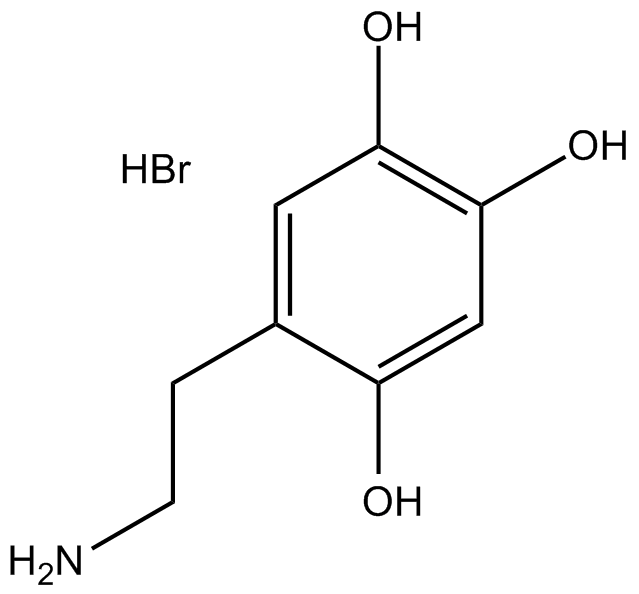6-Hydroxydopamine hydrobromide (Synonyms: 6-hydroxy Dopamine, Oxidopamine, 2,4,5-Trihydroxyphenethylamine) |
| Katalog-Nr.GC16267 |
Oxidopamin (6-OHDA) Hydrobromid ist ein Antagonist des Neurotransmitters Dopamin.
Products are for research use only. Not for human use. We do not sell to patients.

Cas No.: 636-00-0
Sample solution is provided at 25 µL, 10mM.
6-Hydroxydopamine hydrobromide (6-OHDA) is a structural analogue of catecholamines, dopamine and noradrenaline, and exerts its toxic effects on catecholaminergic neurons. The neurotoxin 6-hydroxydopamine continues to constitute a valuable topical tool used chiefly in modeling Parkinson's disease (PD) in the rat [1].
The classical method of intracerebral infusion of 6-Hydroxydopamine hydrobromide, involving a massive destruction of nigrostriatal dopaminergic neurons, is largely used to investigate motor and biochemical dysfunctions in Parkinson's disease [1]
6-Hydroxydopamine hydrobromide undergoes robust auto-oxidation generating cytotoxic H2O2, reactive oxygen species (ROS) and catecholamine quinones which attack endocellular nucleophilic groups [2].
Neurotoxic effects of 6-Hydroxydopamine hydrobromide occur through a two-step mechanism involving accumulation of the toxin into catecholaminergic neurons, followed by alteration of cellular homeostasis and neuronal damage. Intracellular storage of 6-Hydroxydopamine hydrobromide is mediated by the dopamine or noradrenaline membrane transporters (DAT and NAT respectively), which recognize and uptake 6-Hydroxydopamine hydrobromide due to its structural similarity with endogenous catecholamines [3]. 6-Hydroxydopamine hydrobromide is infused unilaterally in the MFB, producing a functional imbalance between the dopaminergic nigrostriatal systems and resulting in motor slowness, indicative of parkinsonian-like akinesia, and typical rotational behaviour in response to dopaminomimetic agents [4].
References:
[1]. Simola N, Morelli M, Carta A R. The 6-hydroxydopamine model of Parkinson's disease[J]. Neurotoxicity research, 2007, 11(3): 151-167.
[2]. Palumbo A, A Napolitano, P Barone and M d'Ischia (1999) Nitrite- and peroxide-dependent oxidation pathways of dopamine: 6-nitrodopamine and 6-hydroxydopamine formation as potential contributory mechanisms of oxidative stress- and nitric oxide-induced neurotoxicity in neuronal degeneration. Chem. Res. Toxicol. 12, 1213-1222.
[3]. Luthman J, A Fredriksson, E Sundstrom, G Jonsson and T.Archer (1989) Selective lesion of central dopamine or noradrenaline neuron systems in the neonatal rat: motor behavior and monoamine alterations at adult stage. Behav. Brain.Res. 33, 267-277.
[4]. Ungerstedt U and G Arbuthnott (1970) Quantitative recording of rotational behavior in rats after 6-hydroxydopamine lesions of the nigrostriatal dopamine system. Brain Res. 24, 485-493.
Average Rating: 5 (Based on Reviews and 38 reference(s) in Google Scholar.)
GLPBIO products are for RESEARCH USE ONLY. Please make sure your review or question is research based.
Required fields are marked with *




















